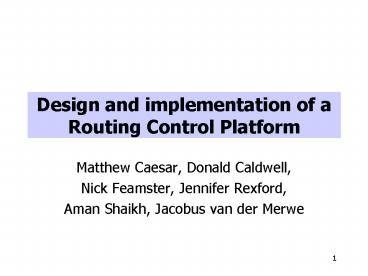Design and implementation of a Routing Control Platform - PowerPoint PPT Presentation
1 / 24
Title:
Design and implementation of a Routing Control Platform
Description:
Learn routes to external destinations (eBGP) Distribute externally learned routes internally (iBGP) Select closest egress (IGP) ... – PowerPoint PPT presentation
Number of Views:29
Avg rating:3.0/5.0
Title: Design and implementation of a Routing Control Platform
1
Design and implementation of a Routing Control
Platform
- Matthew Caesar, Donald Caldwell,
- Nick Feamster, Jennifer Rexford,
- Aman Shaikh, Jacobus van der Merwe
2
How ISPs route
- Provide internal reachability (IGP)
- Learn routes to external destinations (eBGP)
- Distribute externally learned routes internally
(iBGP) - Select closest egress (IGP)
3
Whats wrong with Internet routing?
- Full-mesh iBGP doesnt scale
- sessions, control traffic, router memory/cpu
- Route-reflectors help by introducing hierarchy
- but introduce configuration complexity, protocol
oscillations/loops - Hard to manage
- Many highly configurable mechanisms
- Difficult to model effects of configuration
changes - Hard to diagnose when things go wrong
- Hard to evolve
- Hard to provide new services, improve upon
protocols
4
Routing Control Platform
- Whats causing these problems?
- Each router has limited visibility of IGP and BGP
- No central point of control/observation
- Resource limitations on legacy routers
Solution compute routes from central point,
remove protocols from routers
RCP
network
5
RCP in a single ISP
RCP
- Better scalability reduces load on routers
- Easier management configuration from a single
point - Easier evolvability freedom from router software
6
RCP architecture
Routing Control Platform (RCP)
Route Control Server (RCS)
IGP Viewer (NSDI 04)
BGP Engine
- Divide design into components
- Replication improves availability
- Distributed operation, but global state per
component
7
Challenges and contributions
- Reliability
- Problem single point of failure
- Contribution simple replication of RCP
components - Consistency
- Problem inconsistent decisions by replicas
- Contribution guaranteed consistency without
inter-replica protocol - Scalability
- Problem storing all routes increases cpu/memory
usage - Contribution can support large ISP in one
computer
? Building this system is feasible
8
Potential consistency problem
RCP 1
RCP 2
Use egress D (hence use B as your next-hop)
Use egress C (hence use A as your next-hop)
A
B
C
D
- Need to ensure routes are consistently assigned
- Even in presence of failures/partitions
9
Consistent assignmentSingle RCP, single partition
RCP 1
B
A
- Solution Assign all routers along the shortest
IGP path the same exit router - Ensures forwarding loops dont arise
10
Consistent assignment Single RCP, multiple
partitions
RCP 1
Partition 1
Partition 2
- Solution Only use state from routers partition
in assigning its routes - Ensures next hop is reachable
11
Consistent assignment Multiple RCPs, multiple
partitions
RCP 2
RCP 1
Partition 1
Partition 2
Partition 3
- Solution RCPs receive same IGP/BGP state from
each partition they can reach - IGP provides complete visibility and connectivity
- RCS only acts on partition if it has complete
state for it
?No consistency protocol needed to guarantee
consistency in steady state
12
Scalability solution
- Eliminate redundancy
- Store only a single copy of each BGP route
- Accelerate lookup
- Quickly find routers whose routes changed
- Avoid recomputation
- Compute routes once for groups of routers
- Dont recompute if relative ranking of egress
routers unchanged
13
RCS data structures
14
Example of egress list operation
Ds egress list
B
C
A
C
3
7
4
3
A
4
D
B
7
15
Example of egress list operation
Ds egress list
B
C
A
2
C
3
7
4
3
2
A
4
D
B
7
16
Example of egress list operation
Ds egress list
B
C
A
C
3
5
7
4
3
5
A
4
D
B
7
17
Example of egress list operation
Ds egress list
B
C
A
C
3
1
7
4
3
A
4
D
B
7
1
18
Performance evaluation
- BGP and OSPF logs from Tier-1 ISP backbone
- collected on Aug 1 2004, 500 routers
- Metrics memory usage, update processing time
- Measurement techniques
- Whitebox (instrument code with timers)
- Blackbox (workload generator on separate machine)
- no-queuing (one update at a time)
- real-time (allow updates to queue)
- 3.2 Ghz P4, 4GB memory, Linux 2.6.5
19
Results RCS memory usage
- State for entire ISP
- in 2.5 gigabytes
20
BGP change processing time
All BGP updates processed within 30ms
21
IGP change processing time
22
Towards decoupling BGP from IGP
B
A
10
9
C
- Problem Single link change can affect many paths
- Transient delay/loss, traffic shift, and eBGP
updates - Solution Decouple egress point ranking and cost
- Experiment process only reachability-affecting
events
23
IGP change processing time
New approach reduces processing time
24
Conclusions
- RCP improves routing
- Correct, scalable route distribution
- Eases management and evolvability
- RCP is feasible
- Reliability, scalability, deployability,
consistency - Many open problems
- How to simplify network management
- How to enable new services
- RCP cooperation between ISPs































